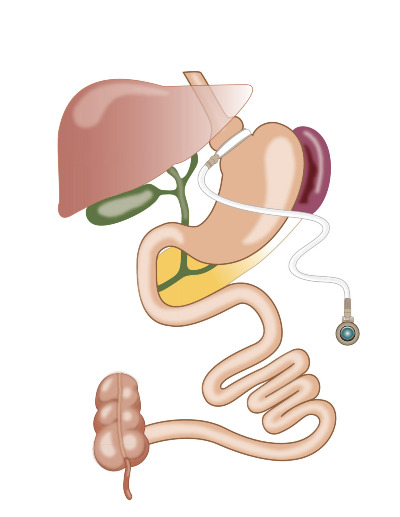



Adjustable gastric banding, often referred to as the "Lap Band procedure" represents a weight loss surgery procedure that is considered "restrictive" only. Since its inception and implementation in the late 1980s, gastric banding has evolved to become the second most popular weight loss surgery procedure.
Surgical Diagram of Laparoscopic Adjustable Gastric Banding During surgery, typically 5 small laparoscopic incisions are made in the abdominal wall to allow working instruments to be placed into the abdominal cavity. The soft tissue around the top part of the stomach is dissected away to allow the placement of a soft, flexible "band". The tubing to the band itself that makes it adjustable is brought out and attached to a small port that sits underneath the skin, but on top of the muscle layer of your abdomen. Weight loss occurrs through "restriction" of portion size and any one meal. The size of the stomach above the band is only 1 ounce in size. As one chews and swallows food, this new pouch is strecthed with only a few bites and gives one the sensation of fullness and satiety with a small meal. As weight is lost, the "restriction" of the band decreases as more food can pass through the opening of the band. This is when the diameter of the band can be tightened by accessing the port and filling it with a small amount of sterile saline. With the band tightened after a fill, food stays in the new stomach pouch longer again making one feel full with only a few bites.
In the average patient, weight loss during the first month is 8 - 10 pounds, followed by 4 - 8 pounds of weight lost monthly depending on dietary compliance and follow-up appointments for adjustments. During the first 12 to 18 months afte surgery, the average patient can expect to lose between 40 to 55% of their excess weight. Unlike the other procedures, however, because the band is "adjustable", restriction and satiety can continue to be increased so that after 2 to 3 years, the ulitmate amount of weight loss is similiar to the gastric bypass or sleeve gastrectomy. It has been said before that surgery is but a tool to help with sustained weight loss and eating healthier, smaller meals. This is most true with gastric banding. Maximum weight loss is only achieved with good dietary compliance and frequent follow-up with your surgeon to chart your progress and provide adjustments when needed.
All surgery comes with risks and while extremely safe, laparoscopic banding comes with its own set.
Want to learn more? Please contact us and comes to one of our free seminars or click on one of the links below. http://www.pbsmg.com/procedure/step.asp http://www.realizeband.com/dtcf/pages/home.htm |





